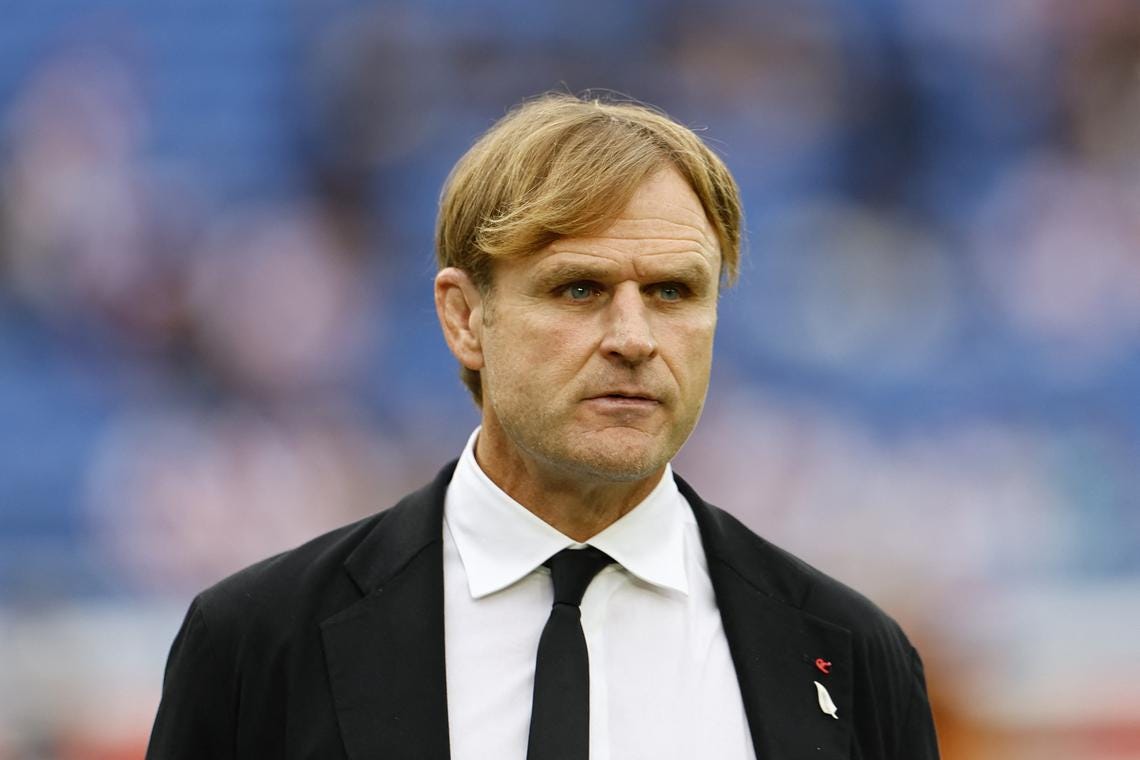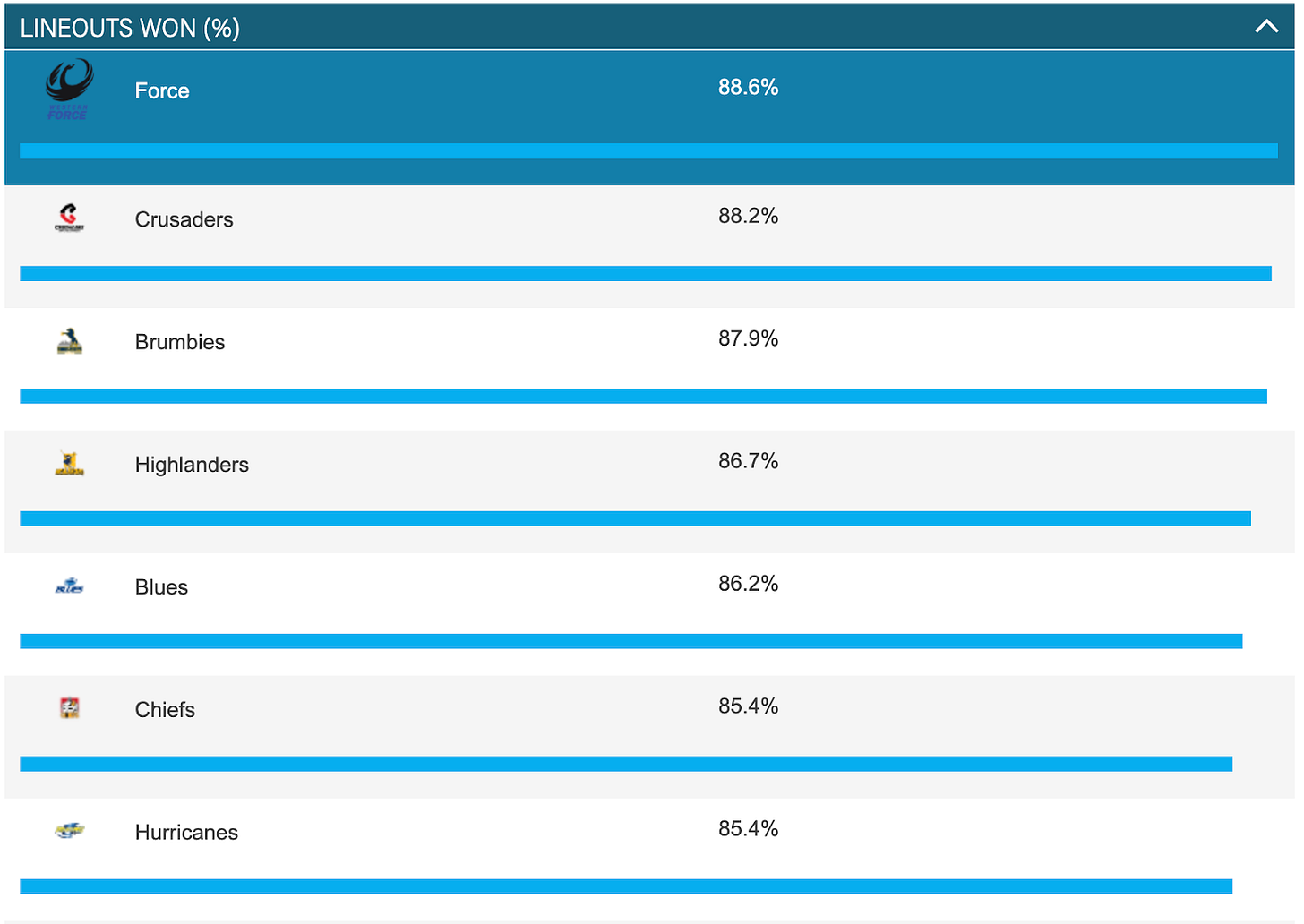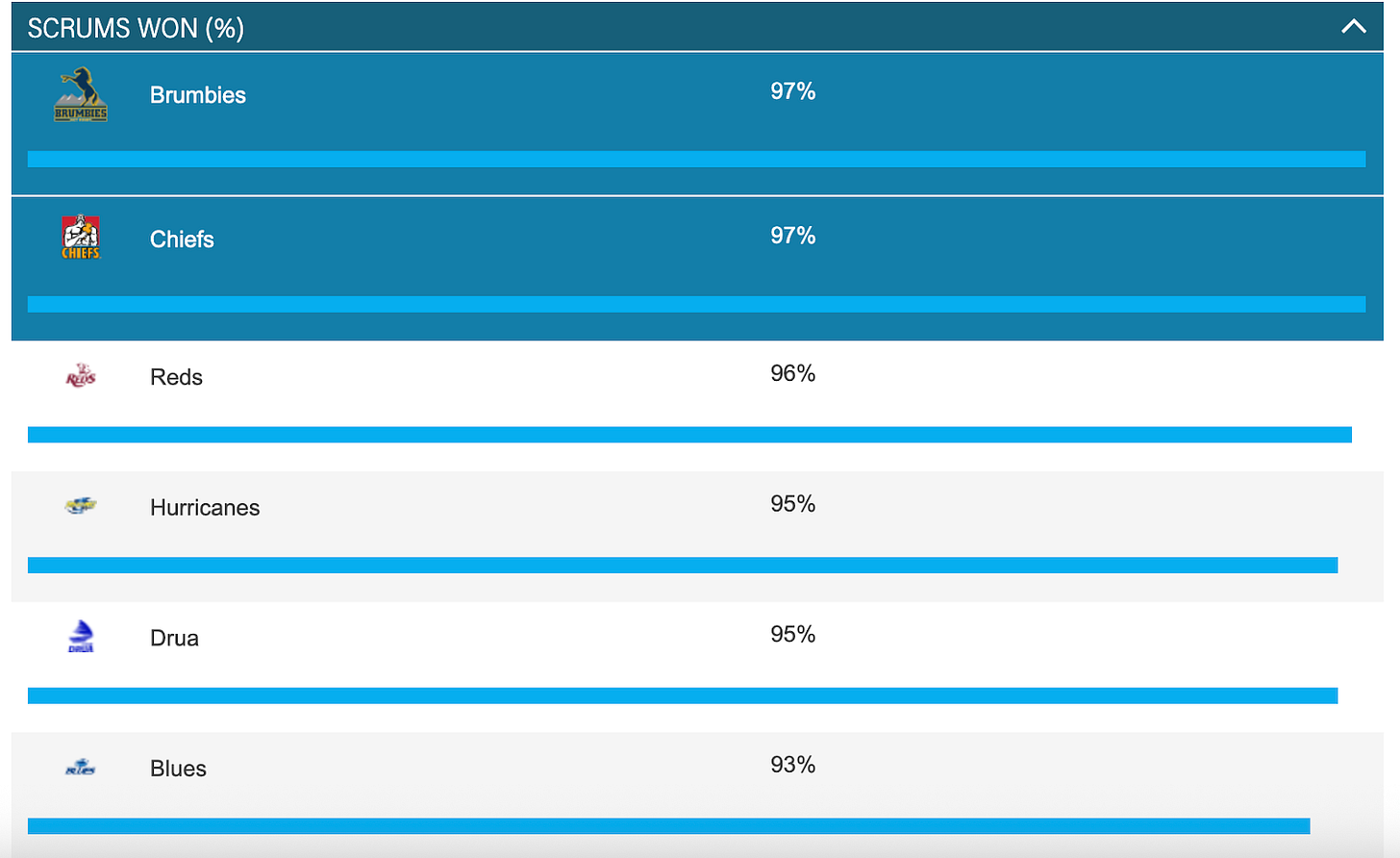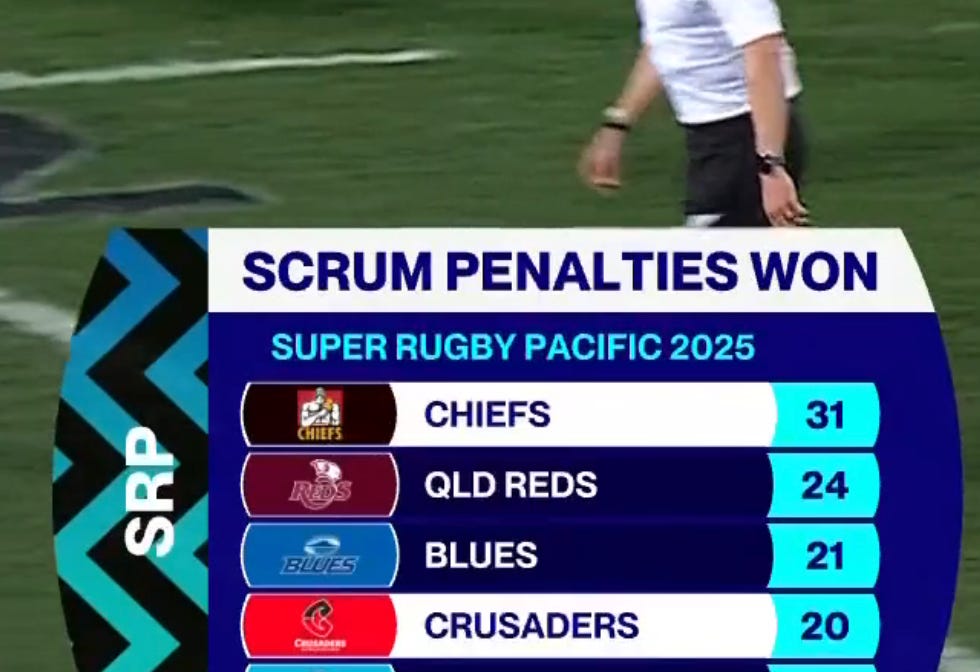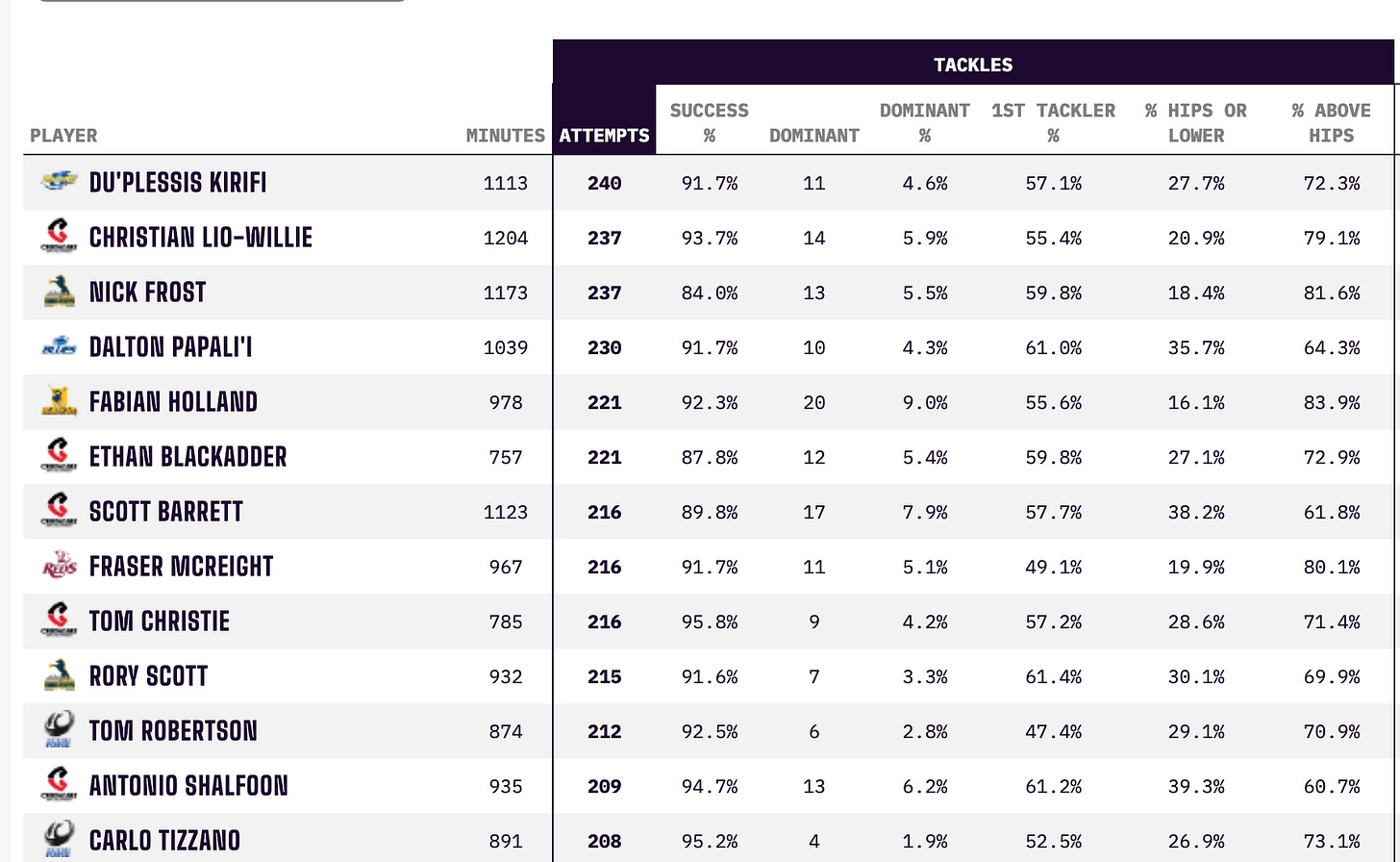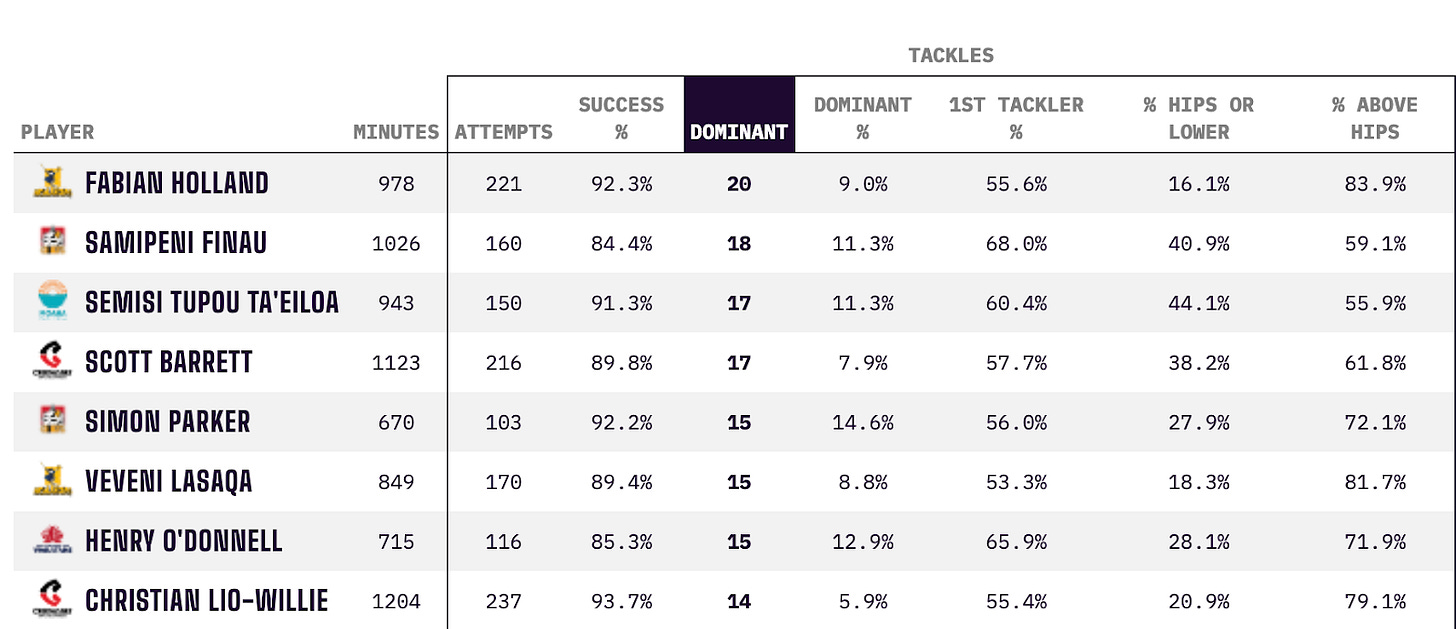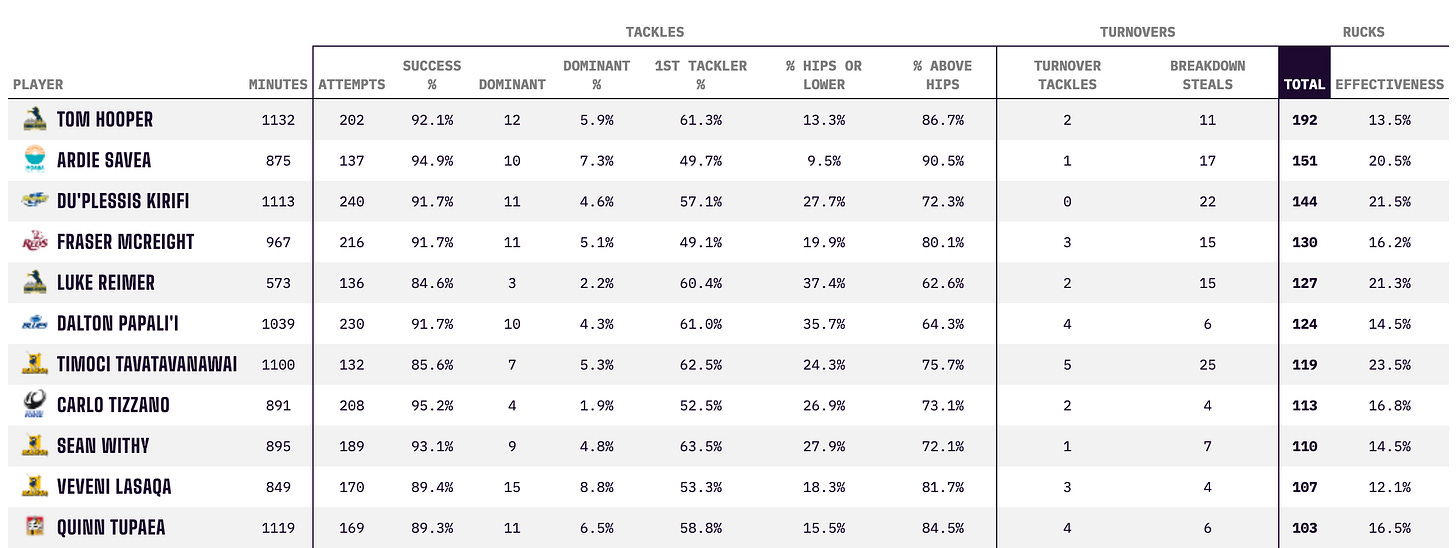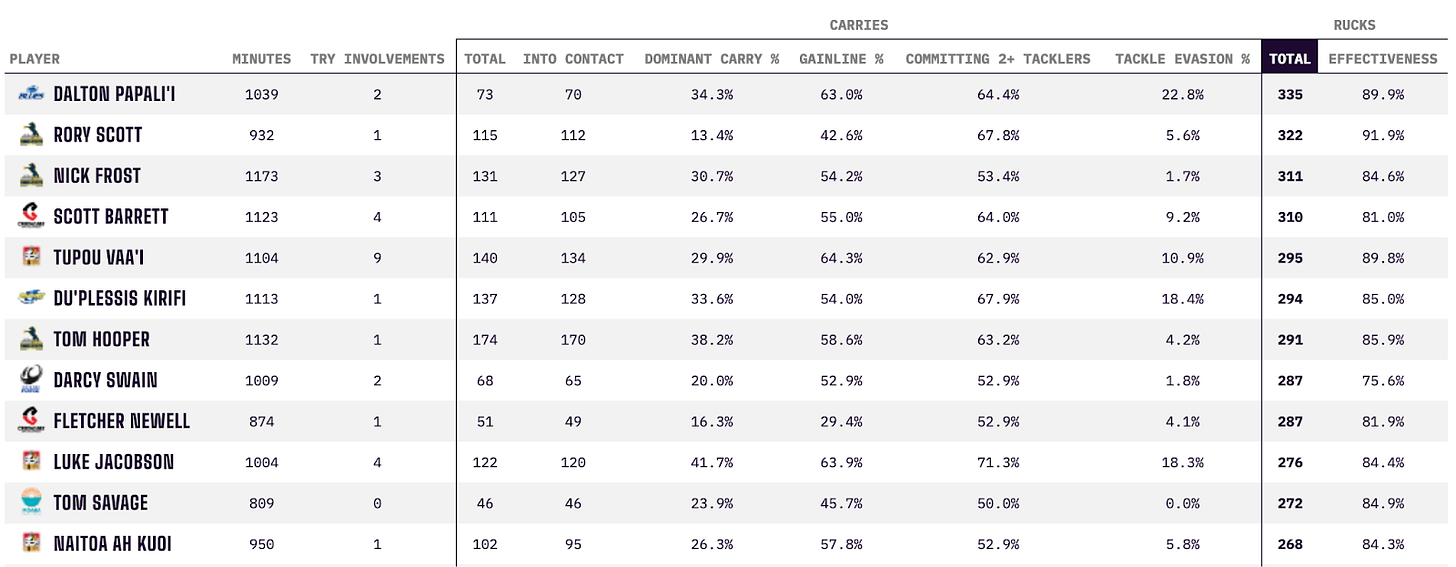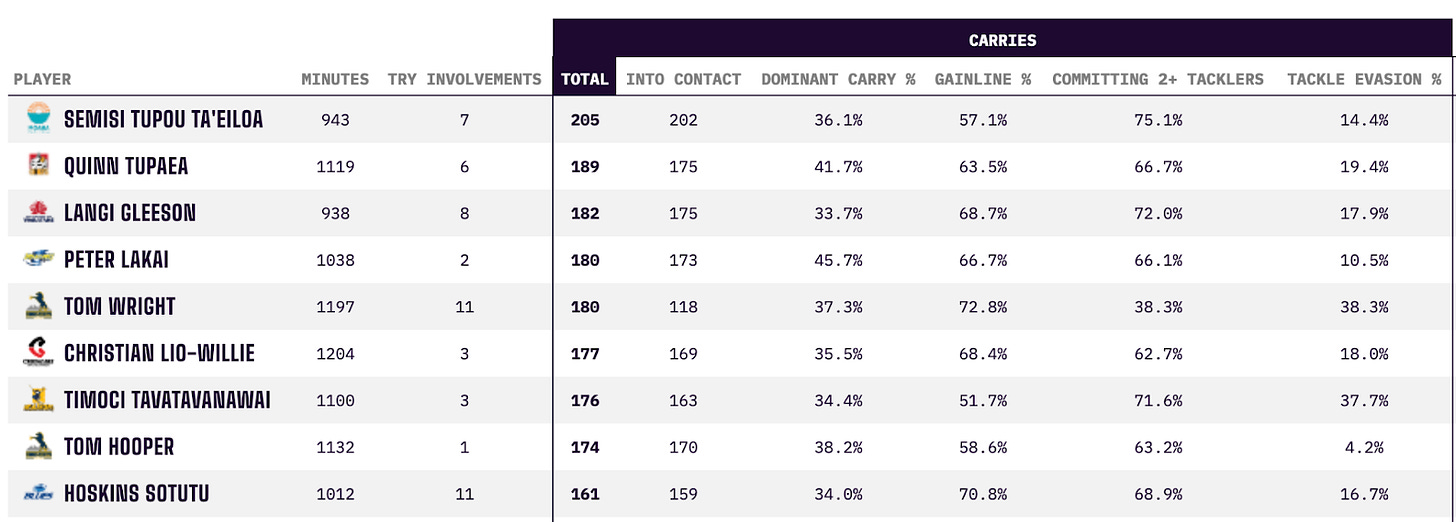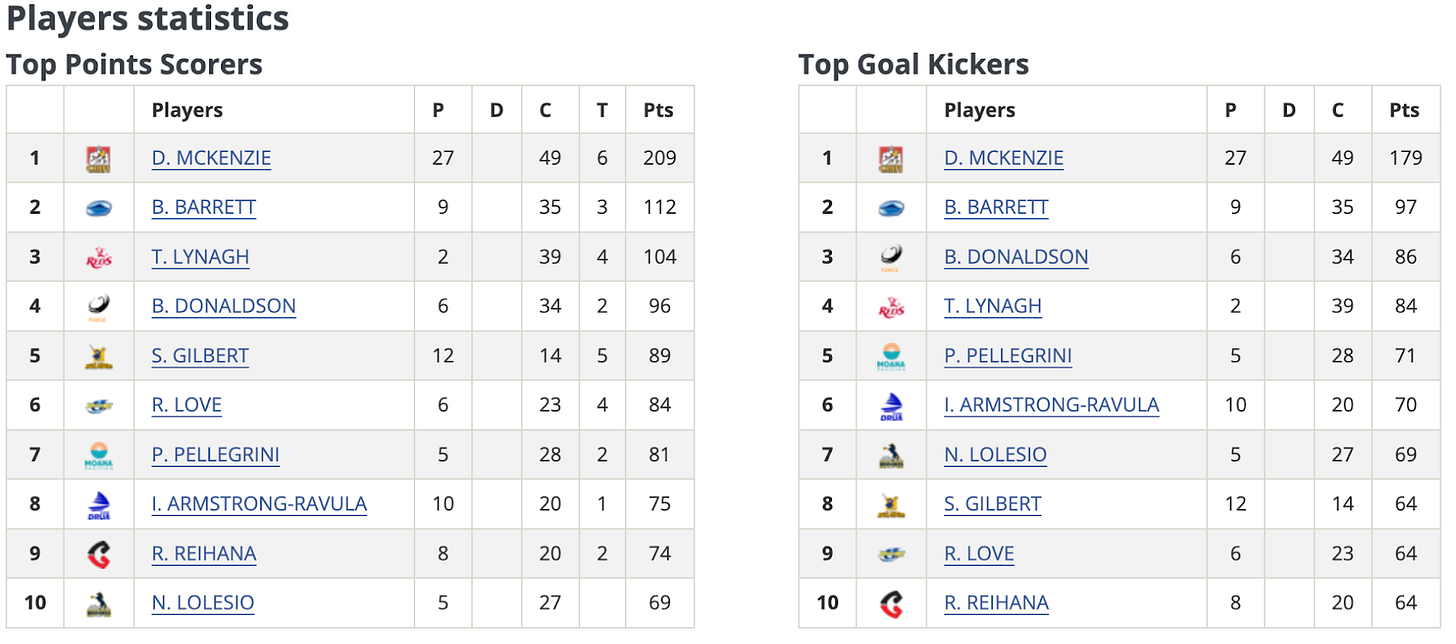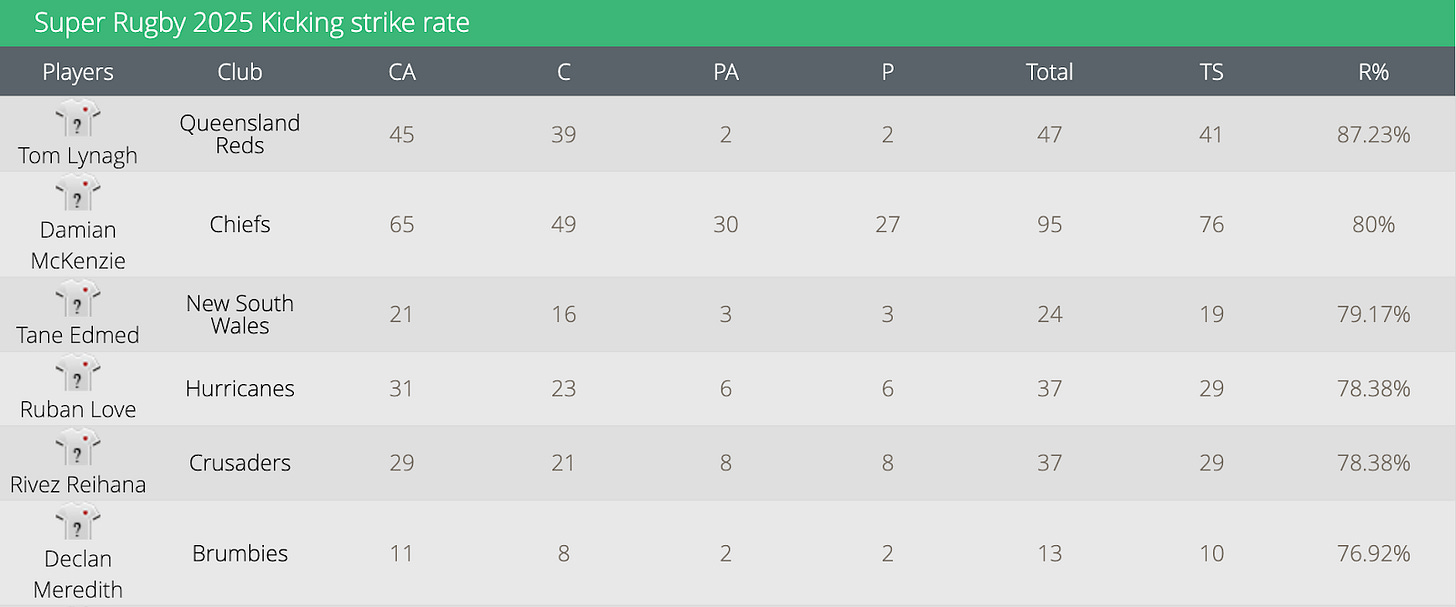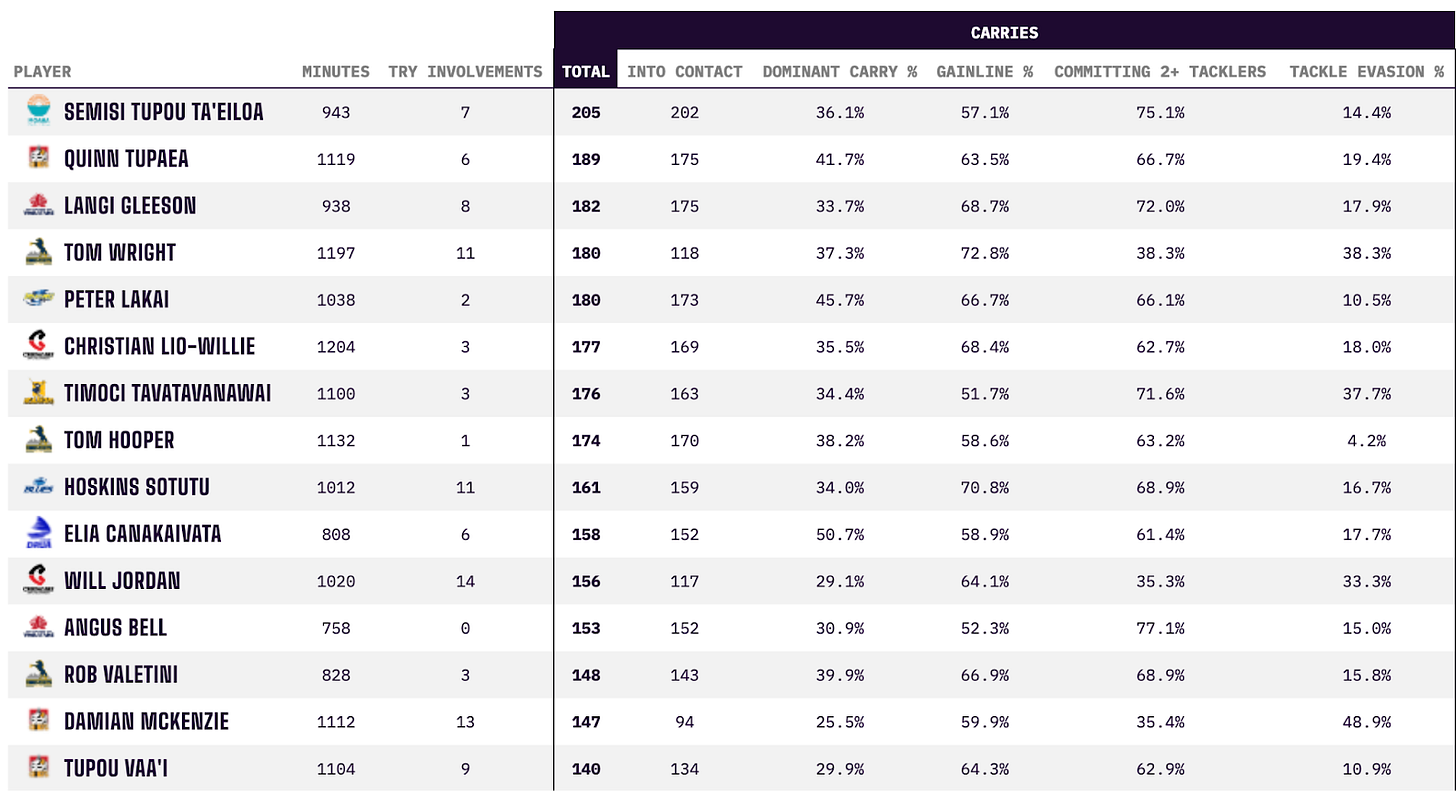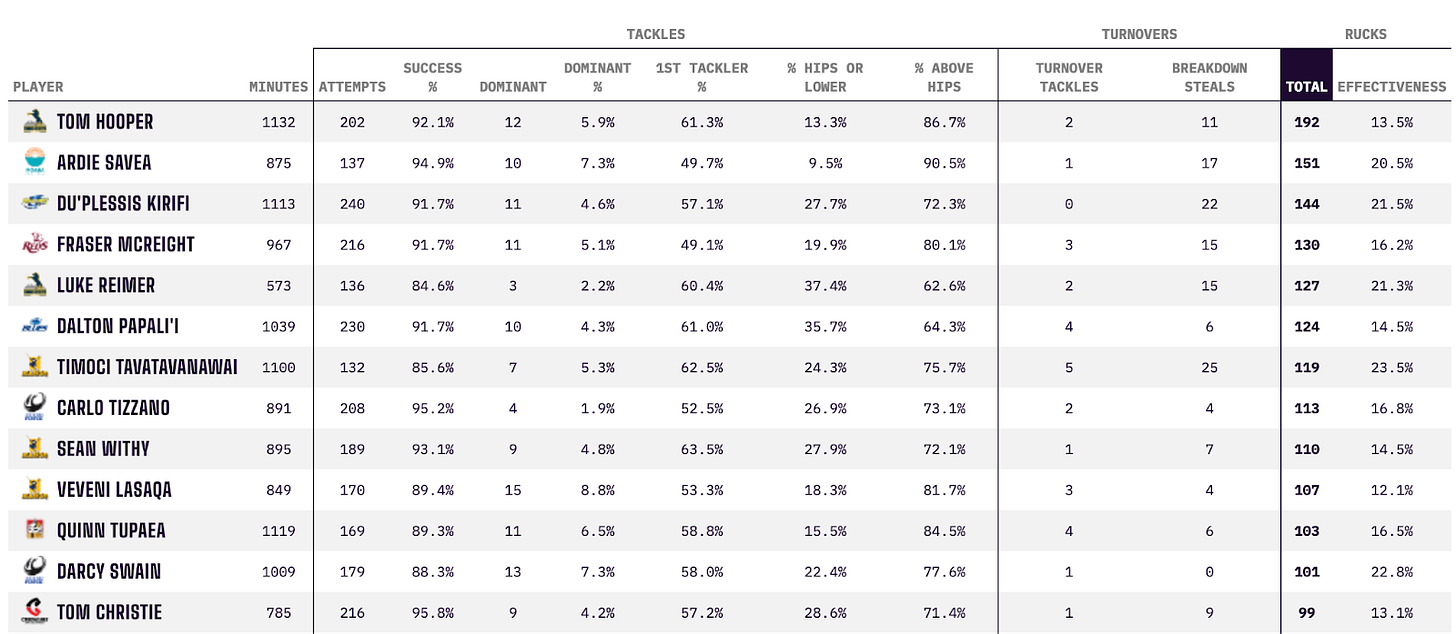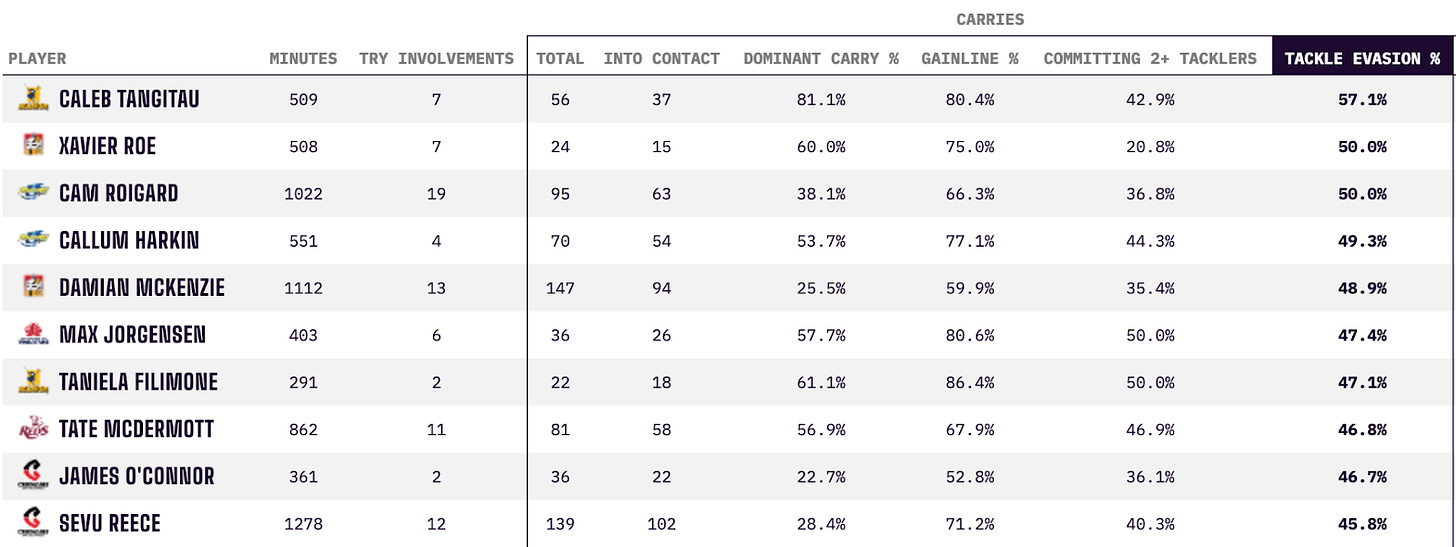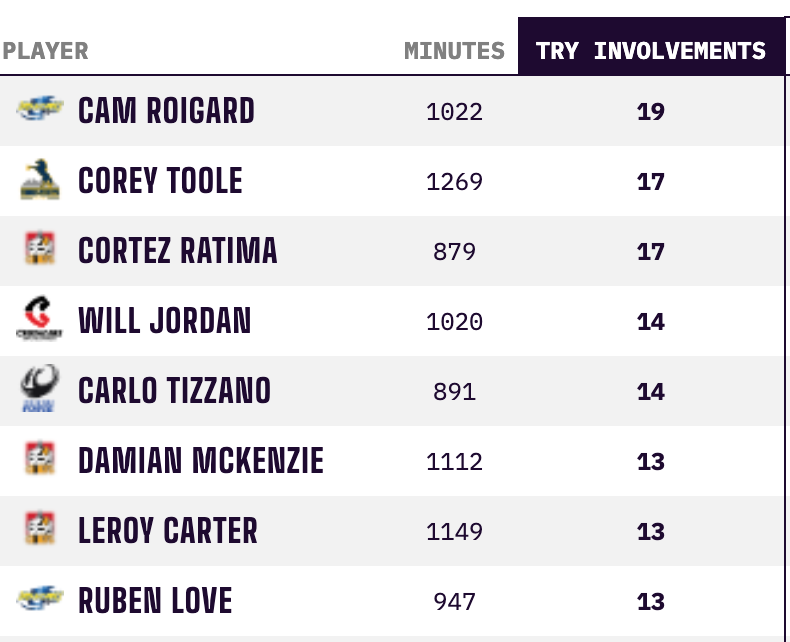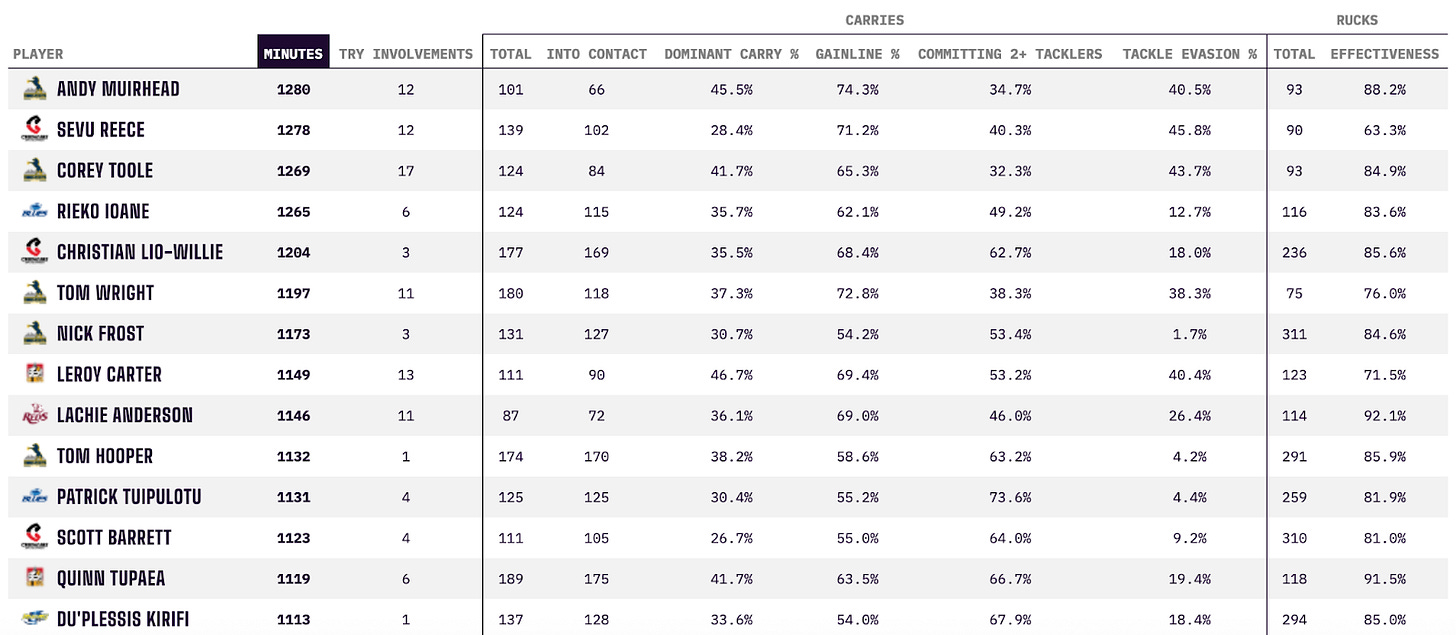The Trends and Statistics Underpinning Scott Robertson’s Biggest Selections—and Omissions—of 2025
A statistical analysis of the trends, inclusions, and omissions underpinning Razor's 2025 squad.
Nothing is more quintessentially Kiwi than debating an All Blacks squad and/or team naming to within an inch of your life; not complaining about the dastardly Australians trying to claim Crowded House and Pavlova, not singing Hey Baby (I Wanna Know) and the unofficial national anthem, Bliss, unapologetically and ad nauseam at every sporting fixture, not even milking The Lord of the Rings for every last cent it’s worth (quite right, too).
Complaining about the All Blacks squad and confidently asserting who you would have selected instead, if, God willing, you were the All Blacks’ coach is a national passtime, a certified rite of passage, and something we’re collectively damn good at. From the 95-year-old grandma down the road who still remembers Pinetree’s debut to the five-year-old kid who just got their first glimpse of the Black jersey and is now hooked for life, everyone has their opinions; whether you land in camp Mo’unga or Barrett (Mo’unga), whether you’re pro or anti Reiko Ioane at centre (anti), and whether you think Will Jordan is better at fullback or on the wing (fullback), the best thing about discussing the All Blacks with fellow diehard fans is that we all have our passionate, informed views.
However, one thing that has often frustrated me about selection discussions and rugby discourse more broadly is the lack of informed, statistical analysis, particularly among the mainstream rugby media, and particularly in contrast to the treasure trove of advanced statistics one can find in sports like football and the NBA these days. It is therefore my stated goal here at The Third Five Eighth to change that, providing serious statistical analysis on major trends and talking points within Rugby Union, with the occasional lighthearted article, obscure ranking list, themed XV, opinion, and reaction thrown in along the way for good measure.
To kick this endeavour off in style, I’d like to take you through the statistics and key trends underpinning Scott Robertson’s biggest All Black selections and omissions of 2025.
Unless otherwise noted, all stats used throughout this article are taken from Opta’s Club Rugby Stats Hub.
The Front Row
Let's start up front with the piggies (are we still allowed to call them that in 2025? Sorry, guys, if not).
Hookers:
Codie Taylor (34, Crusaders / Canterbury, 96)
Samisoni Taukei’aho (27, Chiefs / Waikato, 30)
Brodie McAlister (28, Chiefs / Canterbury, *)
Props:
Ethan de Groot (26, Highlanders / Southland, 29)
Tamaiti Williams (24, Crusaders / Canterbury, 18)
Ollie Norris (25, Chiefs / Waikato, 1)
Tyrel Lomax (29, Hurricanes / Tasman, 44)
Fletcher Newell (25, Crusaders / Canterbury, 22)
Pasilio Tosi (26, Hurricanes / Bay of Plenty, 7)
Largely, the front row is an area where selections are starting to look rather settled, with Brodie McAlister and Ollie Norris standing out as the two main ‘bolters’ up front. Otherwise, it was a case of business as usual as Razor looks to build continuity and develop combinations.
So, why Norris and McAlister? In Super Rugby 2025, there were just six players who hit at least 130 attacking rucks while maintaining a 90+% success rate. Ollie Norris and Brodie McAlister were two of these players (the others being Rory Scott, Tom Christie, Samipeni Finau, and Allan Craig). Accordingly, it seems likely this was one of the key criteria the selectors looked at when handing out new caps.
Beyond this, McAlister was also one of only seven players to make 100+ tackles at a success rate of 95% or better (the others being Tom Christie, Carlo Tizzano, Naitoa Ah Kuoi, Tom Savage, Anton Segner, and Angus Bell) in Super Rugby this season.
Lineout and scrum stats (particularly individual throwing success rates for hookers and scrumming success rates for props) are more difficult to come by. Still, in terms of raw lineout win percentages in Super Rugby 2025, the Crusaders (2nd) and Chiefs (6th), who contribute all three squad hookers, both fare solidly, remembering that a variety of factors, and not just the hooker’s throwing, can influence these numbers.
In terms of scrum win percentages, the Chiefs (first equal) and the Hurricanes (third), who contribute four of the six squad props between them, both held up well.
These stats were taken from super.rugby.
There was also this notable statistic that popped up on screen during the Super Rugby final, showing that the Chiefs’ scrum had won by far the most penalties in Super Rugby this season—seven clear of the Reds in second place—providing further insights into Norris and McAlisters’ selections.
As a Crusaders fan, I do feel compelled to note that this screenshot was taken five minutes into the game, and these, therefore, weren’t the final rankings.
I believe Norris’ selection, to go with Tosi’s last year, also signals a clear focus on selecting ‘impact props.’ To me, players like de Groot and Newell, who are world-class scrummagers but offer little impact around the field, are the types of players who either start or miss the 23 entirely, whereas Tosi and Norris seem to be selected with the explicit goal of adding impact off the bench. Williams and Lomax provide the best of both worlds. Williams (8), in particular, likes a dominant tackle, ranking 11th equal in this metric. Who’d have thought the 1.96m, 144kg behemoth would hit hard, too?
The Locks
Scott Barrett (31, Crusaders / Taranaki, 80) (Captain)
Patrick Tuipulotu (32, Blues / Auckland, 51)
Tupou Vaa’i (25, Chiefs / Taranaki, 38)
Fabian Holland (22, Highlanders / Otago, 1)
It came as a shock to precisely no one to see the towering frame of Fabian Holland receive his maiden call-up. In fact, I think there may have been riots had the Flying Dutchman not been selected.
Really, you only needed to look at Fabian Holland and his 2.04m, 124kg frame to know that he was purpose-built for Test rugby, but allow me to also provide some statistics to back up the eye test. Holland, quite simply, got through his work around the field, ranking 15th in Super Rugby for total attacking rucks hit and fifth for tackles attempted (with a very respectable 92.3% success rate).
Perhaps the most exciting stat, though, is that the big man loves a dominant tackle, with no one making more than Holland’s 20 in Super Rugby this season. Although his captain and locking partner, Scott Barrett, wasn’t too far behind. Now get out there and whack some of those mammoth pieces of Bok Biltong, you two.
Elsewhere, despite questions over his form from some sections of the media (I’m looking at you, Goldie), and calls from others to make Ardie Savea the permanent All Black captain, in a move inspired by the Under-10s mindset of making your best player your captain, Scott Barrett was, obviously, retained as skipper. The Barrett disrespect, frankly, has gotten out of control among some sections of the fanbase recently. If you listen to The Good, The Bad, and The Rugby AUNZ Podcast (and, for my sins, I do), you’ll know from James O’Connor that, internally, the Crusaders were sniggering and teasing Barrett over these criticisms, knowing how well they all thought he was playing at the time. Among a long list of impressive stats, you will find Scott Barrett right near the top of turnover tackles, and he also ranked 9th for total tackles attempted.
The Loose Forwards
Samipeni Finau (26, Chiefs / Waikato, 8)
Ardie Savea (31, Moana Pasifika / Wellington, 94) (Vice-Captain)
Du’Plessis Kirifi (28, Hurricanes / Wellington, 1)
Wallace Sititi (22, Chiefs / North Harbour, 10)
Luke Jacobson (28, Chiefs / Waikato, 24)
Christian Lio-Willie (26, Crusaders / Otago, 1)
I should probably include Tupou Vai’i on that list, too, given his back-to-back selections on the blindside flank. It is Vai’i whom I want to focus on the most, as, despite some questioning the move, hearing that Vai’i was selected at six last week was music to my ears. Finally, it was a belated recognition by the All Blacks of a growing trend in the international game, namely, sticking a massive lump of a bastard at number six (or, at least, on the blindside. Looking at you, South Africa).
The poster boy for this trend is Pieter-Steph du Toit and his hulking two-metre frame, but if you take a whistlestop tour of global rugby recently, you’ll also notice several other locks-come-blindside-flankers:
Ollie Chessum (2.1m) and Tadgh Beirne (1.98m) are regularly playing at six for the Lions on tour so far.
The Wallabies regularly use Rob Valentini (1.93m) at six, but have also often used Tom Hooper (1.99m) recently.
Argentina regularly deploys Marcos Kremer (1.95m) in a similar role as a hybrid lock/blindside.
Italy regularly use Sebastian Negri (1.95m) on the blindside.
Ireland has often used Tadgh Beirne (1.98m), Ryan Baird (1.98m), and Peter O’Mahony (1.93m) in the six shirt.
Wales have tried to deploy Christ Tshiunzi (1.98m) in this role occasionally, though he has more regularly started at lock internationally.
For France, François Cros (1.9m) started every match at six in the 2025 Six Nations, while Anthony Jelonch (1.95m) was preferred at the 2025 World Cup.
In that context, the continued trend towards bigger, hybrid locks/loose forwards is undeniable across the global game. I am not saying the All Blacks need to use Vai’i at six every single week, but I do believe it’s a good idea to have the option to deploy this strategy in our back pockets if required against certain matchups. The extra tactical flexibility this enables can surely be no bad thing in the long run, while also giving us the option to fit three world-class operators—Barrett, Holland, and Vai’i (I’m maybe going a touch early calling by Holland world-class, but I think it’s a safe bet)—into the same XV. This, of course, wasn’t the first time that Vai’i had started at six for the All Blacks, as he was also selected to do so for the World Cup pool game against France in 2023, with a handful of starts at six for the Chiefs also on his resume.
Aside from this, we can also see that work rate was clearly a major factor to break into this side as a loose forward, with the two loose forward debutants, Du’plessis Kirifi and Christian Lio-Willie, also being the two top tackle-attempters in Super Rugby this year, completing these at impressive success rates of 91.7% and 93.7%, respectively.
If we look at dominant tackles, Lio-Willie and fellow loose forward Samipeni Finau both rank highly, as do locks Scott Barrett and Fabian Holland. Simon Parker, who some thought might have been close to making this squad, also pops on this metric and several others. He’s one to keep a close eye on (as is Riley Higgins, on a totally unrelated note, but it’s worth harping on).
Breakdown steals also appear to be a key area of focus, with two debutants, Tavatavanawai and Kirifi, leading the way in this regard in Super Rugby this year, along with the ever-reliable Ardie Savea.
Of course, all of these things mean little if your loose forwards get dominated at the breakdown, so it is heartening to see Savea and Kirifi (as well as midfielders Tavatavanawai and Tupaea) ranking among the top three for total defensive rucks hit in Super Rugby 2025
Really, wherever I turn with these statistics, Kirifi seems to rank somewhere near the top, underscoring just how much he has earned this opportunity.
If we look at total attacking rucks hit, Dalton Papali’i, who was a notable exclusion from this squad, ranks at the top, but behind him, Barrett, Vai’i, Kirifi, Newell, Jacobson, and Ah Kuoi (who has recently been training with the squad) all rank highly.
Finally, Lio-Willie’s ability and willingness to carry the ball—he ranked sixth for total carries and sixth for carries into contact in Super Rugby this year—likely counted heavily in his favour.
The Halfbacks
Cameron Roigard (24, Hurricanes / Counties Manukau, 10)
Cortez Ratima (24, Chiefs / Waikato, 11)
Noah Hotham (22, Crusaders / Tasman, 1)
For starters, it is great news that Cam Roigard and Cortez Ratima finished first and third, respectively, in terms of try involvements in Super Rugby this year; just what you want to see from your key game drivers.
You will also find that Roigard is the second most evasive player in Super Rugby, behind only Caleb Tangitau, with Damien McKenzie, unsurprisingly, also excelling by this metric.
Of the three halfbacks, Roigard ran the ball the most overall in Super Rugby (95 times), though Hotham was the most likely to run it on a per-minute basis:
Cortez Ratima: 44 runs in 879 minutes (0.05 runs per minute)
Cameron Roigard: 95 runs in 1,022 minutes (0.09 runs per minute)
Noah Hotham: 83 runs in 750 minutes (0.11 runs per minute)
Beyond this, it is also interesting to contrast how often the three halfbacks chose to pass/kick. Using the statistics available here from this year's Super Rugby playoffs (since Cam Roigard only played one playoff fixture this year, I have also used his final two regular-season games to give everyone a uniform three-match sample size), we can discover the following:
Cortez Ratima: 186 minutes played, 17 kicks, 195 passes (1.04 passes per minute, 0.09 kicks per minute).
Noah Hotham: 210 minutes played, 22 kicks, 237 passes (1.12 passes per minute, 0.1 kicks per minute).
Cameron Roigard: 208 minutes played, 22 kicks, 267 passes (1.28 passes per minute, 0.1 kicks per minute).
Notably, Ratima runs almost half as often as Roigard and Hotham, and also kicks less. However, his key value and point of difference over the other two options is his effectiveness and involvement at ruck time:
Cortez Ratima: 99 ruck involvements in 879 minutes (0.11 ruck involvements per minute)
Noah Hotham: 54 ruck involvements in 750 minutes (0.072 ruck involvements per minute)
Cameron Roigard: 67 ruck involvements in 1022 minutes (0.065 ruck involvements per minute)
Ratima’s ruck effectiveness rates (25.5% defensively, 86.5% offensively) also dwarf Roigard’s (10.8% defensively, 73.3% offensively) and Hotham’s (7.4% defensively, 74.1% offensively). In this sense, you can class Ratima as a halfback somewhat in the ‘fourth loose forward’ mold.
The First-Fives
Beauden Barrett (34, Blues / Taranaki, 134)
Damian McKenzie (30, Chiefs / Waikato, 61)
Ruben Love (24, Hurricanes / Wellington, 1)
Is it too cheeky to say that Barrett and McKenzie are both feeling increasingly like placeholders for one of the worst-kept secrets in recent NZ rugby memory: Richie Mo’unga will almost certainly return for a crack at the 2027 World Cup? Well, I’m saying it anyway.
I have included Reuben Love here and not at fullback for two reasons:
I believe his long-term future lies at 10.
If you listen to Razor’s recent interviews, he’s repeatedly emphasised his desire to get Love running the cutter at 10 in training and learning the All Blacks’ system behind the scenes.
Otherwise, I can’t imagine there’s too much I can tell you about the established first-fives that you wouldn’t already know. McKenzie ranked 6th for try involvements, 14th for total carries, 5th for tackle evasion percentage, and, interestingly, third for attacking ruck effectiveness (though from a low volume) in Super Rugby this year.
Although he has lost perhaps a touch of his elite evasiveness over the years as he’s aged, Beaudy still ranked 15th for tackle evasion percentage in Super Rugby this year. Elsewhere, it is a lot more difficult to quantify Barrett’s impact on the game in terms of game management, organisation, communication, on-field leadership, manipulating the backfield with his kicking game, and setting up his outsides, with these raw stats.
Credit to the wonderful site, all.rugby, which I use almost daily, for these particular stats.
It is also notable that these two were, once again, the two top point scorers in Super Rugby this year, with Damien McKenzie both attempting (30) and kicking (27) considerably more penalties than anyone else (second is Sam Gilbert with just 13 attempted and 12 successful).
If we look at goal-kicking success percentages, McKenzie ranked second in Super Rugby this year, succeeding with 80% of his kicks at goal, while, more concerningly, Barrett ranked 10th, succeeding with just 74.6% of his attempts.
All time across their careers, you can throw a blanket over the three main goalkicking options in the squad, with just 1.3% separating them:
Damien McKenzie: 594/820 (72.4%)
Beauden Barrett: 786/1066 (73.7%)
Jordie Barrett: 269/473 (73.7%)
As a bonus, though:
Richie Mo’unga: 672/862 (77.9%)
Food for thought when we reach those tight, World Cup knockouts when every point matters.
Credit to rugby.statbunker for these goalkicking statistics.
The Midfield
Anton Lienert-Brown (30, Chiefs / Waikato, 84)
Jordie Barrett (28, Hurricanes / Taranaki, 68) (Vice-Captain)
Rieko Ioane (28, Blues / Auckland, 81)
Quinn Tupaea (26, Chiefs / Waikato, 14)
Billy Proctor (26, Hurricanes / Wellington, 2)
Timoci Tavatavanawai (27, Highlanders / Tasman, *)
I think it would be fair to say no two positions have generated as much discussion and controversy over the past five years as the 12 and 13 jerseys, as we eternally, unfairly compare the latest candidates to Ma’a and Snakey. Suffice it to say, whether you think Reiko Ioane isn’t a 13, you’re team Timoci all the way, or you think someone like Braydon Ennor, Riley Higgins, or AJ Lam was hard done by, you likely already hold a strong opinion on the AB’s best midfield.
Much of the focus will rightly go to the decision to move Rieko Ioane back to the wing and start Billy Proctor at centre, as well as the decisions to recall Quinn Tupaea and hand Timoci Tavatavanawai a debut. Let’s address the former first.
From my layman’s view, I think the decision comes down to two things: defence and distribution. Reiko Ioane had six try involvements in Super Rugby this year, and all of these are tries he scored himself. In the midfield, he still fundamentally has a winger’s instincts and mindset to run first, and accordingly, often misses opportunities to distribute the ball and set up his outside men. In contrast, Proctor had five try involvements (from just 517 minutes, compared to Reiko’s 1,265), scoring three and setting up two.
To put this into further context, here’s a list of try involvements for other New Zealand midfielders in Super Rugby this year, with the brackets indicating tries scored/assisted (e.g. 0/5 indicates zero tries scored and five assisted, whereas 5/0 indicates five tries scored and zero assisted).
Daniel Rona: 10 (6/4)
Bailyn Sullivan: 9 (7/2)
AJ Lam: 7 (4/3)
Quinn Tupaea: 6 (4/2)
David Havili: 6 (0/6)
Peter Umaga-Jensen: 6 (4/2)
Reiko Ioane: 5 (5/0)
Sam Gilbert: 5 (5/0)
Matt Proctor: 5 (3/2)
Tanielu Tele'a: 4 (3/1)
Anton Leinert Brown: 3 (3/0)
Riley Higgins: 3 (0/3)
Timoci Tavatavanawai: 3 (3/0)
Dallas McLeod: 2 (0/2)
Braydon Ennor: 1 (1/0)
Levi Aumua: 1 (1/0)
David Havili, far and away, leads the way with midfield assists, though perhaps he represents a more old-school second-five-eighth in the Carter/Mauger/Giteau mold, which the game seems to have moved on from.
The other area of concern that may have underpinned this decision is defence. In Super Rugby this year, Reiko Ioane made 81.9% of his tackles (116 attempts) compared to 86.6% (67 attempts) for Billy Proctor. To put this into the context of other notable New Zealand midfielders:
Anton Leinert Brown: 93.3% (30 attempts)
Dallas McLeod: 92.4% (118 attempts)
Quinn Tupaea: 89.3% (169 attempts)
Braydon Ennor: 89.1% (46 attempts)
AJ Lam: 87.9% (116 attempts)
Billy Proctor: 86.6% (67 attempts)
Riley Higgins 86.1% (36 attempts)
Peter Umaga-Jensen 86% (93 attempts)
Timoci Tavatavanawai 85.6% (132 attempts)
David Havili: 83.7% (203 attempts)
Daniel Rona: 82.4% (125 attempts)
Levi Aumua: 82.3% (62 attempts)
Reiko Ioane: 81.9% (116 attempts)
Bailyn Sullivan: 81.4% (102 attempts)
Tanielu Tele'a: 80.9% (68 attempts)
Sam Gilbert: 63.9% (36 attempts)
While raw tackling percentages will never tell the whole story defensively (they don’t account for situations where a tackler effectively stops the opposition player’s momentum, but leaves it to someone else to ‘complete’ the tackle, for example), they also don’t make the prettiest reading for Reiko Ioane. In contrast, Anton Leinert-Brown’s immense defensive value too often goes under-appreciated: he is our safest pair of hands defensively in the midfield, and has been for some time now.
Proctor also ranks fifth for the percentage of dominant tackles made, suggesting that when he hits someone, they stay hit.
Moving on to Tupaea and Tavatavanawai, both have been rewarded for supreme, all-court statistical dominance. In Super Rugby 2025, Tupaea ranked second for total carries, second for carries into contact, eighth equal for dominant tackles, ninth equal for breakdown steals, 11th for total defensive rucks hit, and was one of only 13 players to hit 100+ attacking rucks with a 90+% success rate. Of the top 15 carriers by volume in Super Rugby this year, only Peter Lakai and Elia Canakaivata had better dominant carry percentages than Quinn Tupaea.
Defensive ruck work may well have been one of the key selection criteria, as Tavatavanawai also ranks very highly (7th) by this measure, while also ranking 7th for total carries, 1st for breakdown steals, and committing two or more tacklers at a rate of 70+%.
The Outside Backs
Caleb Clarke (26, Blues / Auckland, 29)
Sevu Reece (28, Crusaders / Southland, 32)
Will Jordan (27, Crusaders / Tasman, 41)
The biggest talking point in this year’s outside back selections was, well, the sheer lack of them, with only two specialist wingers, Reece and Clarke, selected in the initial squad. As we’ve since learned, this was likely done with the knowledge that Reiko Ioane was always odds-on to return to the wing during this series.
Caleb Clarke’s clear, overwhelming value comes in his gainline success percentage and his ability to generate front-foot ball consistently. Of the players to make at least 60 carries into contact in Super Rugby this season, Clarke’s gainline percentage of 75% ranked 6th behind only Ngani Punivai, Kini Naholo, AJ Lam, Ponepati Loganimasi, and Miracle Faiilagi. Need to move forward? Give it to Clarke.
On the other hand, Sevu Reece’s main selling point is his evasiveness. He has the highest tackle evasion percentage of anyone in Super Rugby this year (min. 100 carries into contact), and the fifth highest if we lower the qualifying mark to a minimum of 50 carries into contact.
Will Jordan offers a more balanced mix of everything. He ranks 4th for try involvements, 11th for total carries, and also gets busy at the breakdown, hitting 91 attacking rucks and 36 defensive rucks.
I would also like to discuss Will Jordan’s defence at fullback, which I have seen some (baffling, in my opinion) criticism of in the past. Comparing Will Jordan's tackle success percentages (a limited measure which doesn’t tell us everything about a player’s defensive abilities, but does tell us something) to other Super Rugby fullbacks is illuminating. Apples for apples, Jordan’s numbers hold up exceptionally well, noting that you're obviously always going to have lower overall tackle success numbers at fullback defending one-on-one:
Willy Havili: 83.7%, 43 attempts
Shaun Stevenson: 79.4%, 34 attempts
Tevita Ofa: 77.8%, 81 attempts
Will Jordan: 77.2%, 57 attempts
Reuben Love: 73.8%, 42 attempts
Lawson Creighton: 73.5%, 49 attempts
Mac Grealy: 73.6%, 53 attempts
Tom Wright: 71.8%, 39 attempts
Corey Evans: 65.8%, 38 attempts
Isaiah Armstrong-Ravula: 65.1%, 43 attempts
Kurtley Beale: 61.5%, 13 attempts
Jacob Ratumaitavuki-Kneepkens: 60%, 35 attempts
Andrew Kellaway: 58.8%, 68 attempts
Callum Harkin: 58.3%, 24 attempts
Beyond this, Jordan also ranks third for the percentage of dominant tackles made. Between Jordan and Proctor’s success in this area, it’s not a bad skill to have at the back, to send the fear of God into opposition players and make them think twice before running at our last lines of defence.
The Notable Exclusions
These are just a few of the notable exclusions that I have seen bandied about, accompanied by my best statistical guesses of why they have been left out and their (likely) key areas for improvement.
Dalton Papali’i: I found Papali’i’s exclusion a tad surprising, personally, given his excellent ruck and tackling numbers, but I think it probably came down to his carrying. Papali’i made 73 carries in Super Rugby this year, compared to 137 for Kirifi and 177 for Lio-Willie, for example. Those numbers paint a picture that Razor is looking for loosies who can contribute significantly on both sides of the ball, and particularly with ball in hand.
Ethan Blackadder: Blackadder’s gainline percentage (34.8%) is very low. All the other loose forwards selected have gainline percentages of at least 50%, and mostly 60+%. He is industrious, but, like Papali’i (and it pains me to say this as a massive Blackadder fan) not the most effective carrier.
Hoskins Sotutu: Sotutu’s total ruck involvements per minute are rather low (261 total, 0.25 per minute) compared to some of the other loose forwards selected like Ardie (312 total, 0.35 per minute), Kirifi (438, 0.39 per minute—insane, he is a machine), Vai’i (376 total, 0.34 per minute), and Jacobson (345 total, 0.34 per minute).
Leroy Carter: Three words: attacking ruck effectiveness. Of all of the top minute-players in Super Rugby this year, Carter’s attacking ruck effectiveness percentage of 71.5% is by far the lowest, and one of only two below 80% (Tom Wright, the Wallabies fullback, being the other, proving this isn’t necessarily terminal for Carter’s future international prospects).
Thanks so much for reading! This is my first post of hopefully many more to come. If you liked it, the best thing you could possibly do to support me is to subscribe and then share this post around and tell everyone you know who you think might like it: your neighbour, your postman, that person down at the local rugby club, your mate on your most obscure Discord server, hell, maybe you have a direct line to Razor.
The bottom line is, if you liked this and want to see me write more articles like it, I’m not asking for any money, please, just subscribe and share:
If you want to read more of my writing, I also write about cricket over at Beyond Cow Corner. Please consider following that, too!


